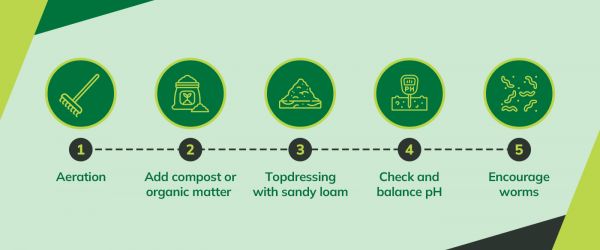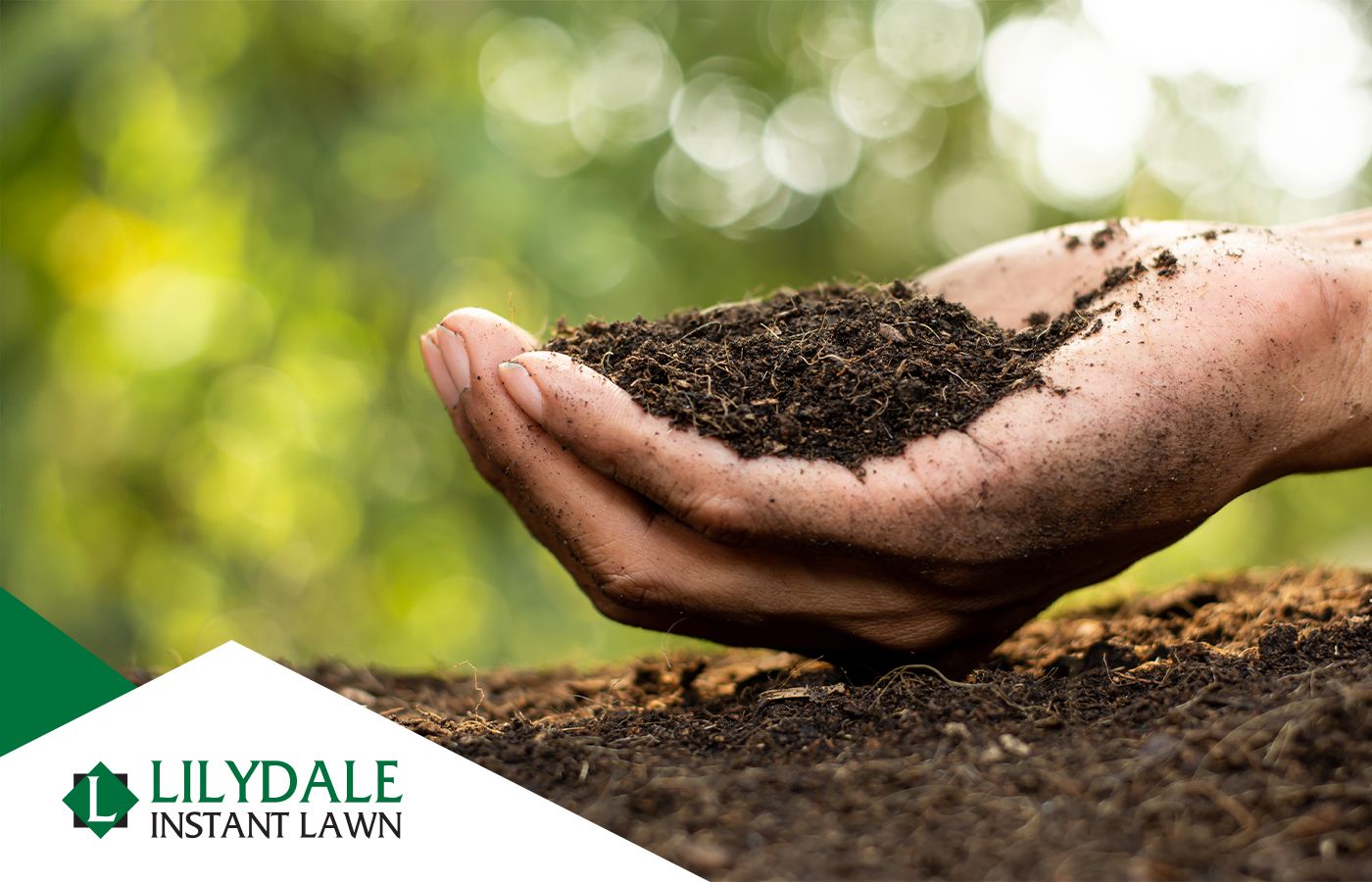8 Minute(s) read
Healthy soil is the foundation of a vibrant lawn. Improving your soil means giving grass roots the right mix of water, oxygen, and nutrients they need to thrive. Without good soil, even the best turf can struggle with poor growth, compaction, or uneven patches.
Improving your soil involves more than adding fertiliser. It consists of creating the proper soil structure and balance. By understanding your soil type and making simple changes, such as adding organic matter, aerating compacted areas, and checking pH levels, you can help get your lawn in peak condition.
Whether laying new turf or caring for an existing lawn, this guide will show you what you need to do to improve lawn soil naturally and achieve a healthy lawn.
Why soil quality matters for your lawn
Soil quality is the foundation of a healthy lawn because it affects how water drains, nutrients are stored, and roots grow. Good soil contains the right mix of soil particles—sand, silt, clay—plus organic matter and living organisms like worms. This combination provides drainage while retaining enough moisture for the grass to stay green.
When the soil is poor, lawns may struggle. Heavy clay soil often compacts and repels water, while sandy soil can drain quickly and lose nutrients. Both must be improved with compost, organic matter, or a soil conditioner to restore balance. Checking soil pH is also essential. If it is too acidic or alkaline, amendments such as lime or gypsum may be required.
At Lilydale Instant Lawn, we recommend preparing quality soil before laying premium turf varieties such as Sir Walter DNA Certified Buffalo or TifTuf Bermuda. With the right soil foundation, these grasses establish faster and deliver long-lasting results. For comprehensive soil mapping guidance in Victoria, you may also consult Data Vic.
What type of soil is best for lawn growth?
Not all soil types support lawns equally. The main soil types—clay, sand, silt, and loam—affect how water, nutrients, and oxygen move through the soil and reach grass roots. Understanding these differences helps you choose or improve the best soil for lawn care.
| Soil type | Pros | Cons | Best use for lawns |
|---|---|---|---|
| Clay soil | Holds moisture and nutrients well | Compacts easily, causing drainage issues and poor aeration | Useful in dry areas if improved with compost or gypsum |
| Sandy soil | Drains water quickly and warms fast in spring | Does not retain enough nutrients or moisture | Works best when mixed with compost or loam |
| Silt soil | Retains nutrients better than sand and improves texture | Can compact when wet, reducing drainage | Best when combined with organic matter for stronger grass growth |
| Loam soil | Balanced drainage, fertility, and moisture retention | Needs regular organic content to stay fertile | Considered the best soil for lawns, turf, and new seeding |
Loam soil is generally the best choice because it combines the advantages of other soil types. It supports grass seed germination, turf establishment, and long-term lawn health.
How to improve poor soil for grass and turf?
If your lawn soil is compacted, drains poorly, or lacks nutrients, you can restore it with a few simple steps. Follow this process to improve poor soil and create a stronger base for grass and turf:
- Test your soil – Use a kit to check soil type and pH balance. Aim for around 6.5–7.0 so essential nutrients are available to the grass roots.
- Aerate compacted areas – Aeration relieves soil compaction, allowing water, air, and nutrients to move deeper. NSW Department of Primary Industries recommends deep tillage for compacted soil.
- Add organic matter – Compost, manure, or shredded bark improve soil structure and fertility while supporting soil organisms like earthworms. Queensland Government notes that organic matter helps soil retain moisture.
- Balance nutrients with fertiliser – Apply a slow-release fertiliser to deliver essential nutrients without overwhelming the grass.
- Top up with quality topsoil – Use a thin layer of sandy loam topsoil to fill holes, level the surface, and improve drainage.
- Encourage worms – Earthworms naturally aerate soil and help with water movement, making nutrients available to plant roots.
These steps can transform poor soil into a healthy lawn foundation supporting turf growth and long-term soil health.

Improving lawn soil naturally
You don’t always need synthetic fertilisers to achieve a healthy lawn. Improving the soil naturally supports long-term lawn health while reducing chemical inputs.
Here are some natural ways to improve your soil for grass:
Leave clippings on your lawn – Grass clippings decompose and return nutrients directly to the soil surface, reducing the need for extra fertiliser.
Add organic compost – Compost adds organic matter, improving soil structure and helping it retain moisture without waterlogging.
Encourage worms – Earthworms aerate soil, improve drainage, and recycle organic material into nutrients that grass can use.
Use manure or organic fertiliser – Natural fertilisers release nutrients slowly, supporting grass growth without overwhelming the soil.
Apply a thin top dressing – A light layer of sandy loam mixed with organic material helps improve poor soil and supports soil organisms.
How to prepare lawn soil for new turf
Preparing your lawn soil properly before laying new turf ensures strong root growth and long-term lawn health. Follow these steps for soil preparation:
- Check your existing soil – Test the soil type and pH balance. Aim for around 6.5–7.0 so the grass roots can access essential nutrients.
- Till and loosen the soil – Break up compacted areas to improve drainage and allow plant roots to grow deeper into the soil.
- Add organic matter – Mix in compost or manure to boost organic content and soil fertility.
- Level the soil surface – Use a rake to smooth uneven areas and create a level lawn for easier turf installation.
- Apply topsoil – Spread a thin layer of sandy loam or high-quality topsoil as an underlay to improve soil structure and moisture retention.
- Fertilise before laying turf – Apply a starter fertiliser to provide nutrients during establishment.
Lawn care tips to keep your soil in peak condition
Keeping your soil and lawn healthy requires consistent care. Even naturally occurring loam soil needs ongoing maintenance to prevent compaction and nutrient loss. Use these tips to maintain the health of your soil and support a greener lawn:
- Aerate regularly – Relieve compaction so water drains properly and soil particles don’t clump together. Aeration also improves air flow and helps living organisms like worms thrive.
- Apply fertiliser wisely – Use a slow-release fertiliser to deliver nutrients evenly. Over-fertilising poor soil can repel water and make it harder for grass to absorb nutrients.
- Mow at the right height – Avoid scalping your lawn. Mowing correctly helps maintain grass cover, reduces stress on roots, and prevents heavy soil from drying out.
- Manage foot traffic – Too much foot traffic can compact soil, reduce drainage, and damage grass roots. Rotate play or activity areas where possible.
- Check out your soil – Regularly test pH levels to ensure they stay between 6.5–7.0. Acidic or alkaline soil may need amendments such as lime or gypsum.
Applying these tips will give your lawn the balance of nutrients and soil structure to stay resilient and green throughout the year.
FAQs
How can I improve lawn soil for healthy grass?
To improve lawn soil, aerate compacted areas, add compost or topsoil, and use a slow-release fertiliser. These steps improve soil structure, reduce compaction, and give grass roots access to nutrients, helping you achieve a healthier lawn.
What’s the best soil and lawn combination?
The best soil and lawn combination is loam soil, which is made of different proportions of sand, silt, and clay. Loam provides balanced drainage, fertility, and structure, making it ideal for turf growth and maintaining strong grass roots.
How do I fix hydrophobic soil in lawns?
Hydrophobic soil repels water, causing patchy grass and poor growth. Improve soil by applying wetting agents, organic matter, or gypsum. Encouraging worms also helps water and nutrients penetrate the soil, preventing pest issues and supporting a resilient lawn.
Create healthier soil for a greener lawn
Improving your soil is the best way to support a healthy lawn, whether repairing poor soil or preparing for a new lawn. Here are the main points to remember:
- Good soil balances nutrients, air, and moisture that every lawn needs.
- Loam soil is the best lawn base with sand, silt, and clay proportions.
- Aeration and amendments such as compost or a soil conditioner help with water drainage and prevent compaction.
- Organic matter and the right amendment can improve poor soil that is too acidic, alkaline, or heavy.
- Checking soil pH around 6.5–7.0 and encouraging worms ensures the health of your soil long-term.
Improving your soil naturally makes the nutrients available to grass roots, helping your lawn stay greener and more resilient. For expert turf advice and support from the leaders in lawn care, explore our premium instant lawn varieties. Whether you’re laying the turf for a new lawn or improving existing soil, we’ll provide the right soil and lawn solutions to keep your lawn in peak condition.
















